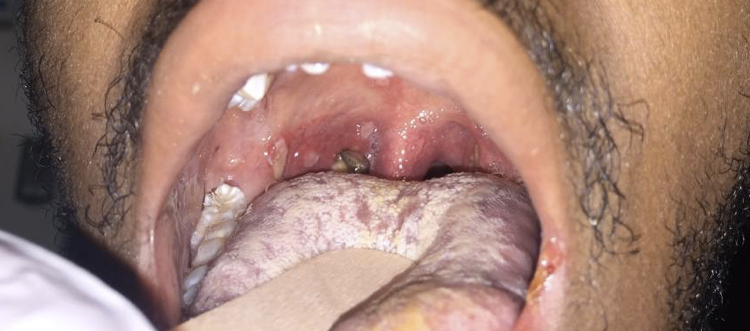Case Presentation: A 20-year-old man with a history of type 1 diabetes mellitus presented with five days of sore throat and intermittent fever. Two days prior to presentation, he was evaluated with findings including tachycardia with a heart rate of 124, fever to 38.7 degrees C, and an exam notable for tonsillar & oropharyngeal exudate with cervical lymphadenopathy. At that time, rapid strep testing was performed and returned negative with a discharge diagnosis of viral infection. Patient returned three days later due worsening sore throat, decreased oral intake, difficulty swallowing, voice change and vomiting. He also noted his glucose levels were consistently above 500 for the past 48 hours but reported not administering his insulin due to poor oral intake. He was tachycardic with a heart rate of 110 , afebrile and had noted weight loss of 10 lbs in the past 2 days. On exam, he appeared sick with palatal ulcers, posterior oropharyngeal erythema and tonsillar exudate (Image 1). The remainder of his exam was otherwise normal. Laboratory values were significant for glucose of 432, bicarbonate of 11.9 (19-25 meq/L). Repeat rapid strep and a monospot were negative. He was admitted to the hospital for Diabetic Ketoacidosis (DKA) management and further work up. During hospitalization, patient admitted to having unprotected intercourse with a female four weeks prior to presentation. HIV test was positive, and the patient was diagnosed with acute retroviral syndrome triggering his DKA exacerbation.
Discussion: Infection is the most common cause of sore throat in both adults and children with 25 – 45% being due to viruses. Bacteria make up another common cause of pharyngitis, which is predominantly due to Group A Streptococcus. Though initially this patient’s presentation is consistent with these common etiologies, his persistence of symptoms and severity on exam make rare causes plausible. Conducting a thorough sexual history is essential to determine likelihood of infections such as HIV and Gonorrhea. Acute Retroviral Syndrome from acute HIV is estimated to be symptomatic in 40-90% of patients, with 40% of those having pharyngitis. Presence of painful mucocutaneous lesions can be distinctive of HIV. Ulcers are typically shallow and well demarcated, though typically without exudate, which was not the case here. Other symptoms in acute retroviral syndrome include cervical lymphadenopathy, fever, myalgias, weight loss, diarrhea and headache, many of which this patient had on further questioning. Typical presentation is 2-4 weeks after viral acquisition, which was consistent with this patient’s sexual history. Diagnosing acute retroviral syndrome early in its course allows for immediate initiation of HAART therapy which can prevent progression to AIDS and other opportunistic infections. Compared to previous decades, acute retroviral syndrome is an uncommon hospitalist problem. It is essential for hospitalists to remember typical and atypical presentations of acute HIV, especially when the presumed diagnosis does not fit.
Conclusions: Sore throat in children and adults is most commonly due to respiratory viral pathogens. However, persistence of symptoms, negative strep tests and physical exam findings of painful ulcers should trigger further work up including HIV for acute retroviral syndrome.

